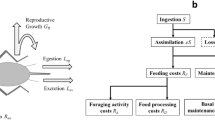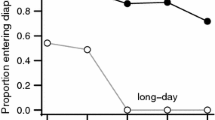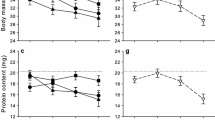Abstract
Growing animals must alter their energy budget in the face of environmental changes and prioritize the energy allocation to metabolism for life-sustaining requirements and energy deposition in new biomass growth. We hypothesize that when food availability is low, larvae of holometabolic insects with a short development stage (relative to the low food availability period) prioritize biomass growth at the expense of metabolism. Driven by this hypothesis, we develop a simple theoretical model, based on conservation of energy and allometric scaling laws, for understanding the dynamic energy budget of growing larvae under food restriction. We test the hypothesis by manipulative experiments on fifth instar hornworms at three temperatures. At each temperature, food restriction increases the scaling power of growth rate but decreases that of metabolic rate, as predicted by the hypothesis. During the fifth instar, the energy budgets of larvae change dynamically. The free-feeding larvae slightly decrease the energy allocated to growth as body mass increases and increase the energy allocated to life sustaining. The opposite trends were observed in food restricted larvae, indicating the predicted prioritization in the energy budget under food restriction. We compare the energy budgets of a few endothermic and ectothermic species and discuss how different life histories lead to the differences in the energy budgets under food restriction.





Similar content being viewed by others
References
Benyi K, Habi H (1998) Effects of food restriction during the finishing period on the performance of broiler chickens. Br Poult Sci 39:423–425
Bernays EA, Woods HA (2000) Foraging in nature by larvae of < i > Manduca sexta</i > —influenced by an endogenous oscillation. J Insect Physiol 46:825–836
Brody S (1945) Bioenergetics and growth. Reinhold, New York
Campero M, De Block M, Ollevier F, Stoks R (2008) Metamorphosis offsets the link between larval stress, adult asymmetry and individual quality. Funct Ecol 22:271–277
D’Amico LJ, Davidowitz G, Nijhout HF (2001) The developmental and physiological basis of body size evolution in an insect. Proc R Soc Lond B Biol Sci 268:1589–1593. doi:10.1098/rspb.2001.1698
Davidowitz G, D’Amico LJ, Nijhout HF (2003) Critical weight in the development of insect body size. Evol Dev 5:188–197. doi:10.1046/j.1525-142X.2003.03026.x
De Block M, Stoks R (2008) Short-term larval food stress and associated compensatory growth reduce adult immune function in a damselfly. Ecol Entomol 33:796–801. doi:10.1111/j.1365-2311.2008.01024.x
Dmitriew CM (2011) The evolution of growth trajectories: what limits growth rate? Biol Rev 86:97–116. doi:10.1111/j.1469-185X.2010.00136.x
Esperk T, Tammaru T (2004) Does the ‘investment principle’model explain moulting strategies in lepidopteran larvae? Physiol Entomol 29:56–66
Glazier DS (2002) Resource-allocation rules and the heritability of traits. Evolution 56:1696–1700. doi:10.1111/j.0014-3820.2002.tb01481.x
Glazier DS (2005) Beyond the “3/4 power law”: variation in the intra- and interspecific scaling of metabolic rate in animals. Biol Rev 80:611. doi:10.1017/s1464793105006834
Glazier DS, Calow P (1992) Energy allocation rules in Daphnia magna: clonal and age differences in the effects of food limitation. Oecologia 90:540–549
Greenlee KJ, Harrison JF (2005) Respiratory changes throughout ontogeny in the tobacco hornworm caterpillar. Manduca sexta J Exp Biol 208:1385–1392. doi:10.1242/jeb.01521
Grodzinski W, Klekowski RZ, Duncan A (1975) Methods for ecological bioenergetics. Blackwell Scientific Publications, Oxford
Hahn DA, Denlinger DL (2011) Energetics of insect diapause. Annu Rev Entomol 56:103–121. doi:10.1146/annurev-ento-112408-085436
Hayes SE, McClintock JB, Watson CJ, Douglas Watson R (1992) Growth, energetics and food conversion efficiency during the last larval stadium of the tobacco hornworm (Manduca sexta). Comp Biochem Physiol A Physiol 102:395–399. doi:10.1016/0300-9629(92)90153-h
Hayes M, Jiao L, Tsao T-h, King I, Jennings M, Hou C (2014) High temperature slows down growth in tobacco hornworms (Manduca sexta larvae) under food restriction Insect Sci In press doi:10.1111/1744-7917.12109
Honěk A (1993) Intraspecific variation in body size and fecundity in insects: a general relationship Oikos:483–492
Hou C (2013) The energy trade-off between growth and longevity. Mech Ageing Dev 134:373–380. doi:10.1016/j.mad.2013.07.001
Hou C (2014) Increasing energetic cost of biosynthesis during growth makes refeeding deleterious. Am Nat 184:233–247. doi:10.1086/676856
Hou C, Zuo WY, Moses ME, Woodruff WH, Brown JH, West GB (2008) Energy uptake and allocation during ontogeny. Science 322:736–739. doi:10.1126/science.1162302
Hou C, Bolt KM, Bergman A (2011a) Energetic basis of correlation between catch-up growth. health maintenance, and aging. J Gerontol A Biol Sci Med Sci 66A:627–638. doi:10.1093/gerona/glr027
Hou C, Bolt KM, Bergman A (2011b) A general model for ontogenetic growth under food restriction. Proc R Soc B Biol Sci 278:2881–2890. doi:10.1098/rspb.2011.0047
Jokela J (1997) Optimal energy allocation tactics and indeterminate growth: life-history evolution of long-lived bivalves. In: Evolutionary Ecology of Freshwater Animals. Springer, pp 179–196
Kearney MR, White CR (2012) Testing metabolic theories. Am Nat 180:546
Kingsolver JG, Woods HA (1997) Thermal sensitivity of growth and feeding in Manduca sexta caterpillars. Physiol Biochem Zool 70:631–638
Kitaysky AS (1999) Metabolic and developmental responses of alcid chicks to experimental variation in food intake. Physiol Biochem Zool 72:462–473
Konarzewski M, Starck JM (2000) Effects of food shortage and oversupply on energy utilization, histology, and function of the gut in nestling song thrushes (Turdus philomelos). Physiol Biochem Zool 73:416–427
Kooijman S (2010) Dynamic energy budget theory. Cambridge University Press, Cambridge
Lighton JRB (2008) Measuring metabolic rates: a manual for scientists. Oxford University Press, USA
Maltby L (1994) Stress, shredders and streams: using Gammarus energetics to assess water quality
Mangel M, Munch SB (2005) A life-history perspective on short- and long-term consequences of compensatory growth. Am Nat 166:E155–E176. doi:10.1086/444439
Mangel M, Stamps J (2001) Trade-offs between growth and mortality and the maintenance of individual variation in growth. Evol Ecol Res 3:583–593
McCarter RJ, Palmer J (1992) Energy-metabolism and aging—a lifelong study of Fischer-344 rats. Am J Physiol-Endocrinol Metab 263:E448–E452
Metcalfe NB, Monaghan P (2001) Compensation for a bad start: grow now, pay later? Trends Ecol Evol 16:254–260
Morgan IJ, Metcalfe NB (2001) Deferred costs of compensatory growth after autumnal food shortage in juvenile salmon. Proc R Soc Lond B Biol Sci 268:295–301. doi:10.1098/rspb.2000.1365
Naim M, Brand JG, Kare MR, Kaufmann NA, Kratz CM (1980) Effects of unpalatable diets and food restriction on feed efficiency in growing rats. Physiol Behav 25:609–614. doi:10.1016/0031-9384(80)90360-1
Nijhout HF (1975) A threshold size for metamorphosis in the tobacco hornworm. Manduca sexta (L) Biol Bull 149:214–225
Nijhout H, Davidowitz G, Roff D (2006) A quantitative analysis of the mechanism that controls body size in Manduca sexta. J Biol 5:16
Ocak N, Erener G (2005) The effects of restricted feeding and feed form on growth, carcass characteristics and days to first egg of Japanese quail (Coturnix coturnix japonica). Asian Austral J Anim Sci 18:1479
Pietrzak B, Grzesiuk M, Bednarska A (2010) Food quantity shapes life history and survival strategies in Daphnia magna (Cladocera). Hydrobiologia 643:51–54
Reynolds SE, Nottingham SF (1985) Effects of temperature on growth and efficiency of food utilization in fifth-instar caterpillars of the tobacco hornworm, Manduca sexta. J Insect Physiol 31:129–134. doi:10.1016/0022-1910(85)90017-4
Roff DA (2001) Life history evolution. Sinauer Associates, Sunderland
Rønning B, Mortensen AS, Moe B, Chastel O, Arukwe A, Bech C (2009) Food restriction in young Japanese quails: effects on growth, metabolism, plasma thyroid hormones and mRNA species in the thyroid hormone signalling pathway. J Exp Biol 212:3060–3067. doi:10.1242/jeb.029835
Sears KE, Kerkhoff AJ, Messerman A, Itagaki H (2012) Ontogenetic Scaling of metabolism, growth, and assimilation: testing metabolic scaling theory with manduca sexta larvae. Physiol Biochem Zool 85:159–173
Stearns SC (1992) The evolution of life histories. Oxford University Press, Oxford
Steinberg CE, Ouerghemmi N, Herrmann S, Bouchnak R, Timofeyev MA, Menzel R (2010) Stress by poor food quality and exposure to humic substances: Daphnia magna responds with oxidative stress, lifespan extension, but reduced offspring numbers. Hydrobiologia 652:223–236
Timmins WA, Bellward K, Stamp AJ, Reynolds SE (1988) Food intake, conversion efficiency, and feeding behaviour of tobacco hornworm caterpillars given artificial diet of varying nutrient and water content. Physiol Entomol 13:303–314. doi:10.1111/j.1365-3032.1988.tb00482.x
West GB, Brown JH (2005) The origin of allometric scaling laws in biology from genomes to ecosystems: towards a quantitative unifying theory of biological structure and organization. J Exp Biol 208:1575–1592. doi:10.1242/jeb.01589
West GB, Brown JH, Enquist BJ (1997) A general model for the origin of allometric scaling laws in biology. Science 276:122–126
Withers PC (1992) Comparative animal physiology. Saunders College Pub, Fort Worth
Acknowledgments
We gratefully acknowledge the careful reviews and suggestions of three anonymous reviewers. We would like to thank Dr. Rex Gerald for his help with measuring combustion energy content of larval tissue and feces, Dr. Toomas Tammaru and Dr. Douglas Glazier for their excellent suggestions that helped to develop the hypothesis, and Dr. Wenyun Zuo for her enlightening discussion.
Author information
Authors and Affiliations
Corresponding author
Additional information
Communicated by: Sven Thatje
Electronic supplementary material
Below is the link to the electronic supplementary material.
ESM 1
(DOCX 172 kb)
Rights and permissions
About this article
Cite this article
Jiao, L., Amunugama, K., Hayes, M.B. et al. Food restriction alters energy allocation strategy during growth in tobacco hornworms (Manduca sexta larvae). Sci Nat 102, 40 (2015). https://doi.org/10.1007/s00114-015-1289-0
Received:
Revised:
Accepted:
Published:
DOI: https://doi.org/10.1007/s00114-015-1289-0




